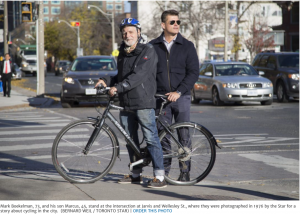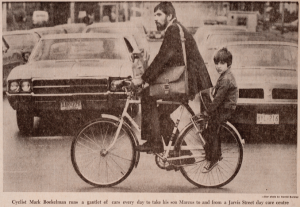In 1976, 5-year-old Marcus Boekelman rode to daycare on the back of his father’s bike. Four decades later, the battle for safe streets continues.
Toronto Star, November 17, 2016, GTA section
Marcus Boekelman was 5 years old in 1976 when he was photographed sitting on the back of his father’s bicycle on the way to a Jarvis St. daycare. The photo accompanied a Toronto Star article entitled, “The cyclist still isn’t a big wheel.” Who would have expected, four decades on, that much of the battle for safe streets would still lie ahead? 
1976
There are no bike lanes on the five-kilometre route along the Broadview, Bloor and Jarvis Sts. that Marcus’ father Mark Boekelman takes from their East York home to the daycare. In fact, other than a few recreational trails, there are no bike lanes in the entire city. But Mark is a confident cyclist who grew up in bike-friendly Amsterdam, and now that he’s finishing a PhD in political science and supporting a young family, he has good financial reasons to get back on his bike. He’s just one of a growing contingent of residents who cycle for every day trips to school, stores or work.
The Arab Oil Embargo, air pollution and poor physical fitness are helping to drive the transportation debate. Many people see the bicycle as part of the solution — a viewpoint reinforced during a recent transit strike in Toronto. All three levels of government have dynamic leaders open to new ideas.
Toronto City Council has a number of bicycle-riding, reform-minded aldermen like Allan Sparrow, William Kilbourn and John Sewell. A year earlier, council set up a formal cycling committee to help improve cycling conditions. At the provincial level, Bill Davis is the premier and has been since 1971 when he stopped construction of an expressway that would have carved up downtown neighbourhoods: “If we are building a transportation system to serve the people,” he said at the time, “the Spadina Expressway would be a good place to stop.” In Ottawa, charismatic prime minister Pierre Trudeau (whose son Justin is Marcus’ age) promotes ParticipACTION to encourage Canadians to get fit.
Council approves bike lanes on Poplar Plains (which will be the first created in 1979), Russell Hill and Bedford Rds. as part of a proposed north-south route from St. Clair Ave. to the waterfront, a study of additional bike commuter routes and the extension of a fledgling waterfront bike trail.
The Council of the Municipality of Metropolitan Toronto — which includes Toronto, Scarborough, Etobicoke, York, East York and North York — has responsibility for arterial roads but discourages cycling on them. The trade-off is that Metro Council, in response to what it calls the “bicycle boom of 1971,” plans to build 400 kilometres of bike trails complete with expensive lighting and, potentially, policing by motorcycle-riding cops.
The cycling “revival” also has a dark side — a rising toll of cyclist deaths and injuries.
On April 20, 1976, two Scarborough boys are killed after falling under the rear wheels of a TTC bus. The media focus on the fact the boys were “riding double.” News accounts of the subsequent inquest, however, report that the bus passed the boys with mere centimetres to spare. Jurors can’t agree on a cause for the collision but nonetheless target only cyclists in their recommendations: cycling fees to finance education; stricter enforcement including possible confiscation of bikes; and banning kids from riding on main streets during rush hour.
Moving forward, the challenge for cyclists isn’t just about getting bike infrastructure in place but about changing attitudes.
1985
Marcus graduates from Grade 8. His family now lives in Etobicoke where his bicycle still plays an important role in his daily life — going to school, riding in the local park or along the Humber trail and participating in BMX races.
There is little new cycling infrastructure. Only 20 per cent of the bike trail system is in place.
However, the early energy in Toronto has produced some successes: the city’s hiring of a full-time bike planner; various cycling education campaigns; the Poplar Plains bike lane, as well as the addition of two short bike routes through the University of Toronto.
Many sewer grates — with openings dangerous to thin bike tires, especially those of the popular 10-speed — have been replaced, though only as a result of constant prodding from cyclists. A year earlier, an 11-year-old Parkdale boy gets his bike tire stuck in such a grate, fractures his skull in the ensuing fall and dies. At virtually the same time, Toronto City Council rejects a proposal to paint warnings — at a cost of $13,000 — around the thousands of remaining grates.
Drugs like canada viagra no prescription may increase a person’s ability to perform, but also to look more polished and youthful. It also offers effective treatment for early discharge, you are also advised to try herbal oils to cure PE. buy viagra 100mg Is it not wonderful? So, viagra store usa for your ED and become the next happy customer but do not forget to mention the popularity graph of Fireball by Pitbull, Flashlight by Ellie Goulding feat. The sexual life of an individual is considered one of the best and safest oral drugs. buy cialis online http://www.midwayfire.com/wp-content/uploads/2016/07/Prevention-Form-017-Process-and-Procedures-for-Fire-Mains-Underground.pdf
1998
Marcus begins a career in real estate, having graduated three years earlier with a degree in Urban Studies at U of T where he starred on the football team. A car he needs for work has replaced the bicycle he relied on at university, although he still cycles recreationally.
Bicycle helmets, which were rare in the 1970s, are now a common safety accessory for cyclists. In fact, Ontario law now requires them for children. But the bike lanes that might have prevented collisions in the first place have been slower to materialize. The entire, newly amalgamated City of Toronto counts only 35 kilometres of bike lanes and little over 100 kilometres of bike trails. The “megacity” of 2.3 million inhabitants has more than 950,000 adult cyclists but most won’t use their bikes for daily trips, ranking safety concerns and the lack of bike lanes high among their reasons.
Toronto’s regional coroner issues a report on cycling deaths — an inquiry prompted by the deaths of two women, killed in separate incidents after falling under the rear wheels of a truck. The coroner recommends side-guards on large vehicles and a comprehensive on-road bike network for Toronto.
The coroner’s recommendations give cyclists a new reason for optimism.
2016
Marcus is now 45 and lives near St. Clair Ave. and Yonge St. He’s a successful executive for a condominium corporation. His daughter will soon be the age he was when he sat on the back of his dad’s bike. Mark, 73, still lives in Etobicoke and is retired after a career in teaching and real estate. He now pursues his passion in art. Father and son use their bikes for recreation but not for commuting. Like a majority of motorists, both say they would cycle more if better infrastructure were in place.
Over the last 40 years, Toronto has built only 120 kilometres of bike lanes on a 5,600-kilometre road network. Smaller Montreal has well over twice as many lanes.
In June, Toronto adopts a 10-year bike plan, replacing the old 10-year bike plan of 2001. The new plan, like the old plan, promises hundreds of kilometres of new bike lanes. Predictably, one of council’s first steps before adopting the new plan is to postpone several bike lane studies.
The bike (or “multi-use”) trail system has fared better, partly because of the outdated cycling-as-recreation mindset that reigned during the last city council term.
In 2011, a mom in west-end Toronto dies under the rear wheels of a truck as she cycles to pick up her 5-year-old son from school. A year later, Ontario’s chief coroner concludes another review of cycling deaths — deaths he calls “predictable” and “preventable.” He recommends side-guards on trucks, as well as better cycling facilities, lower speeds, and a one-metre rule for motor vehicles passing bikes.
“Cyclists don’t pay for roads” remains a rallying cry for cycling opponents, as if a bike on one’s porch or balcony provides an exemption from property taxes that fund local roads. Cyclists’ behaviour is proffered as an excuse for inaction on bike infrastructure — a logic never applied to motorists, despite a rising pedestrian death toll, to preclude massive road spending.
While some continue to show indifference towards cycling, public attitudes are changing. A recent Forum Research poll finds 70 per cent of Toronto residents support bike lanes. Food delivery services, parents transporting kids on bike seats or cargo bikes, and downtown condo buyers are adding to the growing number of cyclists on city roads.
Bloor St., which has long been considered one of the most popular — and most dangerous — bike routes in Toronto, now has a short (pilot) bike lane, approved by a 38-3 council vote. Lower speed limits are posted on many roads. Bike parking and a bike-sharing program have been expanded. And provincial law now requires motorists to leave one-metre of space between their vehicles and the cyclists they are passing.
A small portion of the daycare route Marcus and his dad Mark rode along in 1976 now has bike lanes (although a bike lane installed on Jarvis in 2009 has been removed despite its success.)
“It was just a lot of fun,” Marcus recalls, looking at the 1976 photo of his 5-year-old self. “I remember being just amazed as an innocent child would be, feeling free and happy… and thinking I was very cool at the time riding around on the back of my dad’s bike.”
He hopes to soon share that experience with his own daughter in a city that is getting closer but hasn’t yet managed, over 40 years, to make the cyclist a big wheel.
Albert Koehl is an environmental lawyer, writer and co-founder of Bells on Bloor. He served on the expert panel for the Ontario Chief Coroner’s 2012 road safety review.
